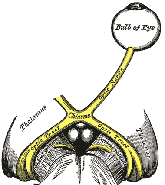
Home

Lab Tour

Lab Syllabus

Papers

Symposium
 Resources Resources
-
-
|
-

Lab 3: Electromyography
[Reading] [Overview] [Useful Links] [Lab Report] [Further Study]
Pre-lab reading
- Lab manual - pages 29-38
- Vander, Sherman, and Luciano - Chapter 12.
- If someone in your lab group has a copy of a human anatomy textbook, bring it to lab this week to look up muscles from which you might want to record.
Overview
To continue your study of muscle and nerve function begun last week, you will use recording electrodes to "listen" to the electrical activity of a muscle during voluntary contractions. The recording of electrical spikes representing action potentials in the muscle fibers is called an electromyogram (EMG). With luck, you may be able to record the activity of a single motor unit in your gastrocnemius muscle and use biofeedback to consciously control its single motor neuron. You can use the EMG to examine changes in electrical activity as force is increased voluntarily and also to examine reflex action of the muscle. The questions you will answer in this investigation include:
- For a minimal contraction, what is the frequency of action potentials for the first motor unit recruited?
- How does electrical activity in the muscle change as force increases?
- What is the role of the gastrocnemius muscle in walking?
- What is the conduction velocity of neurons in the Achilles' tendon reflex arc?
To see pictures of the equipment and how it is used, visit the
lab tour page.
Useful Links
Lab Report
The lab report should include three sections corresponding to sections IV, V, and VI in the lab manual. In each section, describe briefly what you did and what you found. You do not need to repeat the information found in the methods section of the lab manual, but be specific about any other non-standard details. Your verbal description of the results should include answers to all of the questions in that section of the lab manual. Additional content for each section includes:
Single Motor Units and Recruitment. Include one image of a single motor unit recording as displayed in the Chart software.
Role of the Gastrocnemius. Include one image of the gastrocnemius EMG during walking recorded in the Chart software.
Stretch Reflex and Conduction Velocity. Include one image showing the tendon tap and gastrocnemius EMG recorded in the Chart software.
Further Study at Berkeley
Courses related to this lab topic
IB124. Musculoskeletal Biomechanics. The purpose of this course is to teach you how to analyze the musculoskeletal system in humans and other animals using the principles of physics and physiology.
IB125. Locomotion Biomechanics. This course provides a quantitative and integrative analysis of human locomotion. Topics progress from a review of anatomical structures to the muscle activity patterns, quantification of movements (kinematics), forces and torques (kinetics), mechanical and metabolic energy involved in normal human walking and running. Additional topics include the evolution of locomotion, locomotion of quadrupeds and other vertebrate animals, and legged robots.
IB126. Neuromuscular Fatigue. Analysis of mechanisms of nerve and muscle excitation and muscle contraction, and changes occurring during fatigue and recovery.
IB127. Motor Control. We will develop a basic understanding of modern theories of information and control, then analyze neuromotor systems to understand the elements of motor control systems; muscles, sensory transducers and motor systems of the brain. We will use information and control theories to synthesize knowledge of the elements into understanding of the control systems that regulate posture, locomotion, and voluntary movement.
Faculty doing research related to this lab:
- Robert J. Full (IB) Comparative biomechanics, physiology, and functional morphology (PolyPEDAL lab - very cool site!)
-
- Steven L. Lehman (IB) Motor Control
-
-
Links on these pages to commercial sites do not represent endorsement by the University of California or its affiliates.
Department of Integrative Biology
U. C. Berkeley
Send us your comments on the IB132L pages!
-
-
Last updated 1/13/06
- Copyright © Department of Integrative Biology. All rights reserved 2006
-
|
|